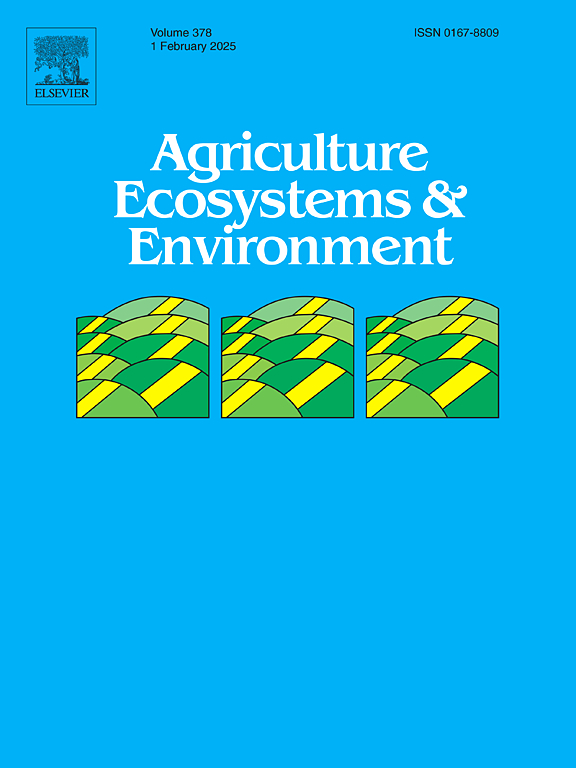早春开花的冬季覆盖作物(Camelina sativa L. Crantz)增加了威斯康辛州(美国)昆虫访花的数量。
IF 6
1区 农林科学
Q1 AGRICULTURE, MULTIDISCIPLINARY
引用次数: 0
摘要
上个世纪农业的扩张和集约化减少了野生昆虫传粉媒介的花卉资源,导致了它们的减少,并可能降低作物生产的授粉服务。能在恶劣气候下越冬的开花覆盖作物,如冬亚麻荠(camelina sativa [L。[Crantz]),可以为春季出现的昆虫提供关键资源,并适合美国中西部上游地区的饲料种植系统,玉米青贮饲料生产是奶牛饲料的重要来源。然而,植物覆盖的数量和覆盖的时间长度,以及将亚麻荠纳入一年生牧草种植系统的实用性,取决于秋季种植时间和覆盖作物组合。采用样点尺度的随机区组试验,测定了冬季亚麻荠和未栽培花卉的春季复盖度和昆虫访花率。本试验采用3种复盖作物组合,为期2年:1)单栽培亚麻荠,2)亚麻荠、小黑麦、毛缕豌豆混合,3)亚麻荠、谷物黑麦、毛缕豌豆混合。第二年,在3个不同的秋季种植时间种植3个单一的亚麻荠,这构成了额外的处理:4)早、5)中、6)晚种植。为了进行比较,我们纳入了不播种的休耕处理,即没有覆盖作物。同时种植的覆盖作物混合物和单一栽培的亚麻荠(所有秋中种植)提供了等量的花卉覆盖,并支持第二年春天相当的昆虫访虫率。对于单一栽培而言,秋季种植较早的亚麻荠春季花卉覆盖度最高,而最晚的种植时间几乎没有花卉覆盖度。尽管蒲公英在许多样地的总花盖度中所占的比例很大,但访花率只随着亚麻荠花盖度的增加而增加。然而,有一个上渐近线,增加更多的亚麻荠并没有进一步增加访问量。我们的研究表明,与冬季休耕相比,冬季亚麻荠在前9月单作或混作时可以在早春为昆虫提供资源,尽管开花时间较短。我们还表明,尽管蒲公英可以在生长季节早期提供花卉覆盖,但亚麻荠可能对昆虫更具吸引力,并提供重要的春季花卉资源。本文章由计算机程序翻译,如有差异,请以英文原文为准。
Early spring-flowering winter cover crop (Camelina sativa L. Crantz) increases insect flower visits in Wisconsin (USA)
The expansion and intensification of agriculture in the last century has reduced floral resources for wild insect pollinators, contributing to their decline and potentially lowering pollination services for crop production. Flowering cover crops that can overwinter in harsh climates, such as winter camelina (Camelina sativa [L.] Crantz), can provide key resources for spring-emerging insects and fit into forage cropping systems in the Upper Midwest region of the United States where corn silage production is an important source of dairy forage. However, the amount of floral cover and length of time that cover is available, as well as the practicality of integrating camelina in annual forage cropping systems, depends on fall planting time and cover crop mix. We performed a plot-scale, randomized block experiment to measure spring floral cover and insect flower visitation of winter camelina and uncultivated flowers. This experiment occurred across 2 years in 3 cover crop mixes: 1) camelina monoculture, 2) camelina, triticale, hairy vetch mix, and 3) camelina, cereal rye, hairy vetch mix. In the second year, 3 camelina monocultures were planted at three different fall planting times, which constituted additional treatments: 4) early, 5) mid, and 6) late plantings. We included an unseeded fallow treatment, i.e., no cover crop, for comparison. Cover crop mixes and camelina in monoculture planted simultaneously (all mid-fall plantings) provided equal amounts of floral cover and supported comparable insect visitation rates the following spring. For monocultures, camelina planted earlier in the fall had the highest spring floral cover, and the latest planting time provided virtually no flower cover. Despite the large proportion of total floral cover attributed to dandelion in many plots, flower visitation exclusively increased with increasing camelina floral cover. However, there was an upper asymptote at which adding more camelina did not further increase visitation. Our study demonstrates that winter camelina can provide resources for insects in early spring when planted in a monoculture or mix the previous September as compared to winter fallow, though the period of flowering is short. We also show that although dandelion may provide floral cover early in the growing season, camelina may be more attractive to insects and provides an important spring floral resource.
求助全文
通过发布文献求助,成功后即可免费获取论文全文。
去求助
来源期刊

Agriculture, Ecosystems & Environment
环境科学-环境科学
CiteScore
11.70
自引率
9.10%
发文量
392
审稿时长
26 days
期刊介绍:
Agriculture, Ecosystems and Environment publishes scientific articles dealing with the interface between agroecosystems and the natural environment, specifically how agriculture influences the environment and how changes in that environment impact agroecosystems. Preference is given to papers from experimental and observational research at the field, system or landscape level, from studies that enhance our understanding of processes using data-based biophysical modelling, and papers that bridge scientific disciplines and integrate knowledge. All papers should be placed in an international or wide comparative context.
 求助内容:
求助内容: 应助结果提醒方式:
应助结果提醒方式:


